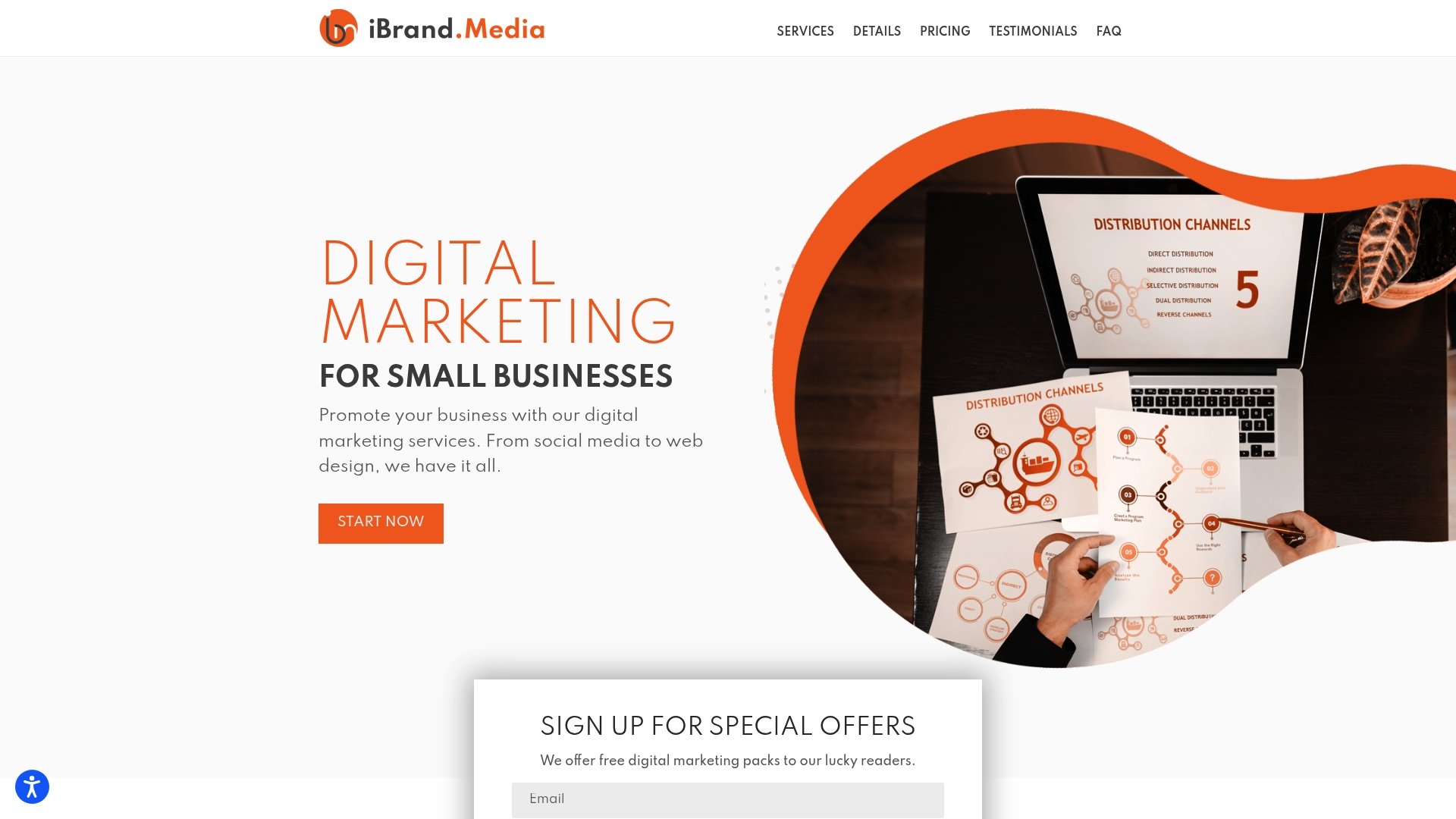Did you know that businesses spent over $600 billion on online advertising worldwide last year? Every click, view, and share shows just how much digital marketing shapes daily buying decisions. Small businesses face stiff competition, but online advertising opens doors to audiences once out of reach. Learning about these digital strategies gives you the edge to attract new customers, increase revenue, and build strong brand recognition in a crowded market.
Table of Contents
- What Online Advertising Means
- Key Types Of Online Advertising
- How Online Advertising Works
- Essential Cost Models Explained
- Targeting And Audience Selection
- Common Pitfalls And Risk Management
Key Takeaways
| Point | Details |
|---|---|
| Effective Digital Strategies | Online advertising encompasses strategies like SEO, social media, and email marketing, helping small businesses connect with a targeted audience. |
| Precision Targeting | Utilizing demographic and behavioral data allows businesses to minimize wasted ad spend and optimize campaign effectiveness. |
| Diverse Advertising Channels | Understanding various online advertising types such as display and mobile ads is crucial for reaching potential customers effectively. |
| Risk Management | Small businesses should implement robust strategies to mitigate security risks and protect their brand reputation in digital advertising. |
What Online Advertising Means
Online advertising is a powerful digital marketing strategy that helps small businesses reach potential customers through internet-based promotional channels. Internet marketing allows businesses to communicate their message across multiple digital platforms without geographic limitations. According to Wikipedia, online advertising encompasses several key strategies including email marketing, search engine marketing, social media marketing, display advertising, and mobile advertising.
At its core, online advertising enables businesses to connect with audiences through targeted digital channels. Digital marketing transforms traditional advertising by offering precision targeting, real-time performance tracking, and significantly lower costs compared to traditional media. As research from Atlantis Press indicates, internet advertising is remarkably effective for attracting new customers, expanding advertisement reach, and increasing business revenue.
The primary goals of online advertising for small businesses typically include:
- Increasing brand awareness
- Generating leads and sales
- Building customer relationships
- Competing effectively in digital marketplaces
- Reaching specific demographic segments
Understanding these digital marketing strategies is crucial for small businesses looking to grow their online presence. Understanding Online Advertising: A 2025 Guide for Small Business can provide deeper insights into developing a comprehensive digital marketing approach that fits your unique business needs.
Key Types Of Online Advertising
Online advertising offers small businesses a diverse range of digital marketing strategies to reach and engage potential customers. According to Wikipedia, the key types of online advertising include display advertising, search engine marketing (SEM), social media marketing, email marketing, and mobile advertising. Each of these channels provides unique opportunities for businesses to connect with their target audience.
Display advertising is a visually compelling approach that allows businesses to communicate their message through graphics, text, logos, animations, videos, and photographs. As Wikipedia explains, digital display advertising focuses on posting company ads on third-party websites, creating interactive experiences that enable deeper brand engagement with users. This type of advertising is particularly effective for businesses looking to build brand awareness and create memorable visual impressions.
The primary types of online advertising include:
- Search Engine Marketing (SEM): Promoting websites by increasing their visibility in search engine results
- Social Media Marketing: Leveraging platforms like Facebook, Instagram, and LinkedIn to reach targeted audiences
- Email Marketing: Sending direct promotional messages to subscriber lists
- Mobile Advertising: Creating ads specifically designed for smartphone and tablet users
- Display Advertising: Using visual banners and graphics across websites
For small businesses looking to navigate these advertising channels effectively, Best Online Advertising Channels for Small Businesses in 2025 can provide strategic insights into selecting the most appropriate digital marketing approach for your specific business needs.
Here’s a comparison of the primary online advertising channels for small businesses:
| Advertising Type | Main Purpose | Typical Platforms | Key Strengths |
|---|---|---|---|
| Search Engine Marketing | Website visibility | Google Ads Bing Ads |
High intent Immediate results |
| Social Media Marketing | Audience engagement | Facebook |
Targeted reach Brand awareness |
| Email Marketing | Direct promotion | Mailchimp Constant Contact |
Personalization Relationship building |
| Mobile Advertising | Mobile user targeting | In-app ads Mobile browsers |
On-the-go reach Location targeting |
| Display Advertising | Visual brand awareness | Google Display Network Website banners |
Eye-catching Large reach |
How Online Advertising Works
Online advertising is a complex ecosystem involving multiple participants working together to deliver targeted messages to potential customers. According to Wikipedia, this process typically involves several key players: publishers who integrate advertisements into online content, advertisers who create and provide ad content, advertising agencies that help generate and place ad copy, ad servers that deliver ads and track performance statistics, and advertising affiliates who conduct independent promotional work.
Targeted advertising forms the core of modern online marketing strategies. As explained by Wikipedia, this approach focuses on directing advertisements to specific audiences based on carefully selected traits. These traits can include demographic information, psychographic characteristics, or behavioral data such as browsing history and previous purchase patterns. The primary goal is to minimize wasted advertising spend by ensuring ads reach the most relevant potential customers.
The typical online advertising workflow includes these critical steps:
- Ad Creation: Developing compelling visual and textual content
- Audience Targeting: Identifying and segmenting potential customer groups
- Platform Selection: Choosing appropriate digital channels
- Ad Placement: Strategically positioning ads on relevant websites and platforms
- Performance Tracking: Measuring ad effectiveness and engagement
Small businesses looking to dive deeper into the nuances of digital marketing can find comprehensive guidance in our Effective Online Advertising Tips for Small Businesses 2025, which offers practical insights into maximizing online advertising performance.
Essential Cost Models Explained
Online advertising pricing models provide small businesses with flexible ways to manage their digital marketing budgets. According to Wikipedia, the advertising industry has evolved to offer multiple payment calculation methods, with historical data showing a significant shift towards performance-based pricing. As of 2012, approximately 32% of online advertising transactions were calculated on a cost-per-impression basis, while 66% focused on customer performance metrics like cost per click or cost per acquisition.
Cost per Mille (CPM) represents one of the fundamental pricing strategies in online advertising. Wikipedia explains that CPM means advertisers pay for every thousand displays of their message to potential customers. However, it’s important to note that not all impressions are created equal. Some impressions may not be charged if they don’t represent a genuine new exposure to an actual potential customer.
The primary online advertising cost models include:

- Cost Per Mille (CPM): Pricing per thousand ad impressions
- Cost Per Click (CPC): Paying only when a user clicks on the ad
- Cost Per Acquisition (CPA): Paying when a specific action is completed
- Cost Per Action (CPA): Similar to CPA, but with broader action definitions
- Cost Per View (CPV): Typically used for video advertising
Small businesses seeking to optimize their advertising spend can find strategic insights in our Paid Advertising Explained: Simple Guide for Small Businesses 2025, which breaks down complex pricing models into actionable strategies.

Targeting And Audience Selection
Audience targeting is the cornerstone of effective online advertising for small businesses. According to Wikipedia, targeted advertising focuses on directing messages to specific audiences based on carefully selected traits. These traits can encompass demographic information, psychographic characteristics, and behavioral data such as browsing history and previous purchase patterns, with the ultimate goal of minimizing wasted advertising spend.
Online advertisers have unprecedented capabilities to collect and analyze audience data. Wikipedia highlights that modern digital advertising allows businesses to track crucial metrics like potential audience size, actual audience response, visitor acquisition channels, conversion rates, and even ad visibility. This granular data empowers businesses to continuously refine and optimize their marketing strategies for maximum effectiveness.
Key audience targeting strategies include:
- Demographic Targeting: Segmenting audiences by age, gender, income, education
- Geographic Targeting: Focusing on specific locations or regions
- Behavioral Targeting: Using browsing and purchase history
- Psychographic Targeting: Analyzing lifestyle, interests, and values
- Retargeting: Reconnecting with users who have previously interacted with your brand
Small businesses seeking to master local audience engagement can find practical guidance in our Targeting Local Customers Online: Proven Strategies for 2025, which offers actionable insights for precision marketing.
Common Pitfalls And Risk Management
Online advertising presents numerous potential risks that small businesses must carefully navigate. According to a US Senate investigation cited by Wikipedia, significant security and privacy concerns exist within the digital advertising infrastructure. These risks primarily stem from the potential for malware distribution through online advertisements, where malicious content can be inserted and triggered without adequate screening or protection.
Digital advertising platforms often connect users to third-party advertisements, which introduces additional complexity and potential vulnerabilities. Wikipedia highlights concerns about ad quality, appropriateness, and the potential for fraudulent or misleading content. Small businesses must remain vigilant and implement robust strategies to mitigate these risks and protect their brand reputation.
Key risk management strategies for online advertising include:
- Carefully Vet Advertising Platforms: Research and select reputable advertising networks
- Implement Strong Security Protocols: Use advanced malware detection tools
- Monitor Ad Performance: Regularly review and analyze advertisement placements
- Establish Clear Content Guidelines: Define strict standards for advertisement content
- Protect User Data: Ensure compliance with privacy regulations
Small businesses seeking comprehensive guidance on navigating online advertising challenges can find valuable insights in our Effective Online Advertising Tips for Small Businesses 2025, which offers practical strategies for safe and effective digital marketing.
Elevate Your Small Business with Smart Online Advertising
The challenge many small businesses face today is cutting through the noise to reach the right audience without overspending. This guide highlights how concepts like targeted advertising, cost models such as CPM and CPC, and selecting the proper digital marketing channels are essential for winning in the online space. If you are looking to grow brand awareness, boost customer engagement, or generate sales online, understanding these online advertising basics is only the first step.
Take control of your digital marketing strategy with ibrand.media, a partner focused on helping SMBs navigate complex advertising landscapes through affordable, customized solutions. Explore practical tips and tailored campaigns in the Uncategorized | Ibrandmedia section to match your unique needs.
Ready to stop guessing and start growing your online presence?

Unlock your small business potential today by visiting ibrand.media and discover how personalized SEO, local advertising, and real-time performance tracking can bring quick, measurable results. Take the next step now—connect with our experts and start transforming your online advertising into real business growth.
Frequently Asked Questions
What is online advertising?
Online advertising is a digital marketing strategy that helps businesses reach potential customers through various internet-based channels, such as social media, email, and search engines.
What are the key types of online advertising strategies?
The key types of online advertising include Search Engine Marketing (SEM), Social Media Marketing, Email Marketing, Mobile Advertising, and Display Advertising.
How does audience targeting work in online advertising?
Audience targeting involves selecting specific traits, such as demographics and online behavior, to ensure ads reach the most relevant potential customers, thereby minimizing wasted advertising spend.
What are common cost models for online advertising?
Common cost models in online advertising include Cost Per Mille (CPM), Cost Per Click (CPC), Cost Per Acquisition (CPA), and Cost Per View (CPV), each offering different payment structures based on ad performance.
Recommended
- Understanding Online Advertising: A 2025 Guide for Small Business | Ibrandmedia
- Understanding Online Advertising: A 2025 Guide for Small Business | Ibrandmedia
- Top Benefits of Online Advertising for Small Businesses | Ibrandmedia
- Affordable Online Advertising Tips for Small Businesses 2025 | Ibrandmedia

Recent Comments